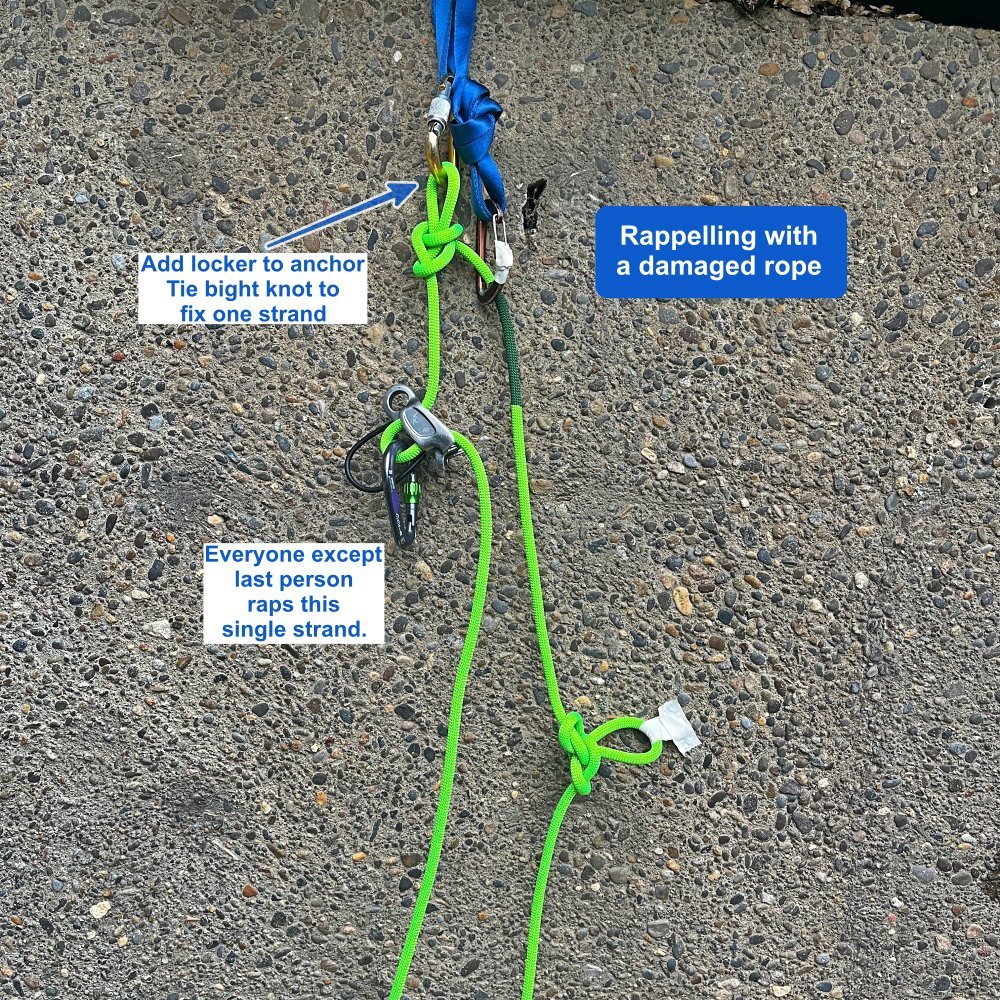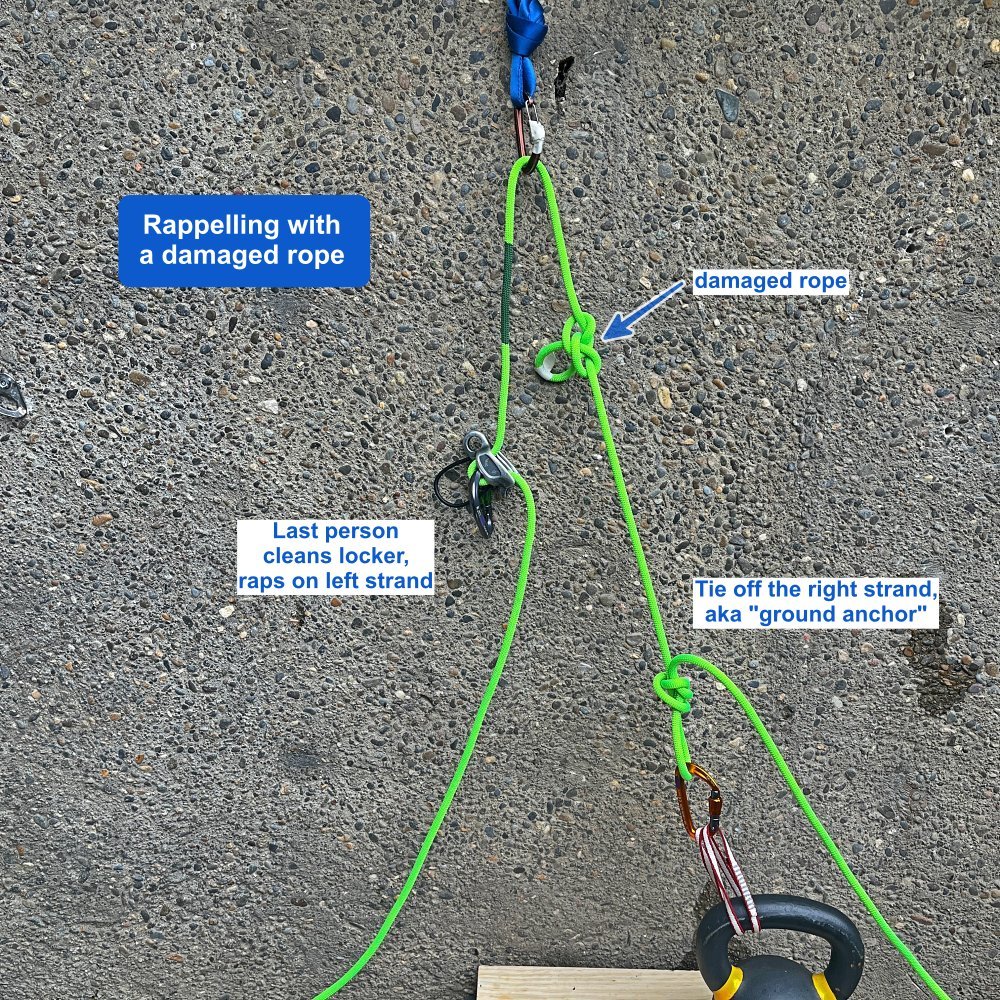How to descend with a damaged rope
Thanks to expert canyoneer Kevin Clark for technical advice on this post. Check out Kevin's book, “Canyoning in the Pacific Northwest”
Note - This post discusses techniques and methods used in vertical rope work. If you do them wrong, you could die. Always practice vertical rope techniques under the supervision of a qualified instructor, and ideally in a progression: from flat ground, to staircase, to vertical close to the ground before you ever try them in a real climbing situation.
While out on a long multi pitch climb, your rope gets damaged by rock fall. What can you do to get down quickly and in relative safety?
Here are a few Crafty Rope Tricks (CRT) to help you do this. And no, you should never have to “pass the knot” on rappel!
Ouch! How do you deal with this?!
If you doing a standard rappel on two strands of rope, and you have a knot in one strand, you should pretty much never need to do any shenanigans to get past the knot.
Having to rappel past a knot in the real world is exceptionally rare. About the only time you might need to do it is on a big wall climb, such as descending fixed single strand ropes that you might find on El Capitan.
Many people think you must rappel past a knot if you have a damaged rope and have to isolate the nicked part in a butterfly or similar knot. Well, that's not the case.
First off, if you have to keep going up, cut the rope at the damaged part and continue climbing on the longest strand. (Hang onto that other part that you cut, you're probably going to need it on the way down.) Be ready to climb shorter pitches and look for alternative anchors.
This will require a careful reading of the route topo map, perhaps some alternative intermediate belay anchors, and maybe some simul-climbing, which is hopefully doable if you’re on a moderate alpine route.
However, if the damage is more in the middle part of the rope, it's quite likely you can’t continue upwards and need to start rappelling. Hopefully this is painfully obvious, but if you were to tie a knot to isolate the damaged part and try to keep going up, that knot will get stuck in the gear placed by the leader.
(Now, there’s an advanced way to bypass even this problem - The leader could continue by rope soloing, feeding the rope out through a clove hitch on their harness. Because they are not being belayed in the normal manner, the knot will not get stuck in the gear. But, this is an extremely advanced technique! Here’s my article about it.
First, assess the damage.
Is the core of the rope (white part) severely damaged? If yes, you may want to actually cut out the damaged part and retie the rope with a stout knot. (A Flemish bend is a good choice.) And you do have a knife with you, right?
If the rope has mild damage, mostly to the sheath, you can probably tie a butterfly knot to isolate the damaged part. The butterfly knot is a great choice for this, because it retains pretty much the full strength of the rope (minus a bit for the knot, of course) and can take a pull in any direction. Tie the knot so the damaged part is isolated in the loop.
Here’s a post with more uses of the butterfly knot, and a video on how to tie it.
Butterfly knot isolating the damaged part of the rope.
So, you've isolated the damaged part and now need to head down. What now?
The more traditional old-school approach is to start doing standard twin strand rappels with the knot in the rope, and have everyone “pass the knot”. This can be time-consuming, dangerous, and, if you have two strands of rope to work with, probably completely unnecessary.
There are actually very few situations in which you really need to pass a knot for real, but they pretty much all involve tying two ropes together for a long single strand rappel, and not when you're doing a normal double strand rappel. For example, cavers on a very long rappel, big wall climbers fixing a rope to the ground or rapping back to a high camp after fixing two pitches, or descending some fixed lines someone else left that turn out to be in lousy condition and have knots in them . . . basically, situations recreational climbers will rarely face.
You can read more on those scenarios, and learn a great technique to pass a knot joining two ropes, at this link.
But, you may be thinking, what if you DO have two rope strands to rappel and there IS a knot in one of them?
No problem, you should never need to deal with passing the knot. There are several ways to approach this problem.
One way to tackle this is to use a carabiner block or rope block (aka “Reepschnur”, Google it). This is common in the canyoneering world but not so much in rock climbing. This method essentially uses the damaged strand of the rope as a pull cord. You use a carabiner or knot tied near the anchor to “block” the damaged side of the rope from pulling through the anchor, and rappel on the “good” side of the rope.
This is definitely a valid technique if you’re experienced with it and absolutely know what you're doing. However, there are some downsides to consider:
Most climbers have never done this. Trying it for the first time way off the deck with a damaged rope is Less Than Ideal.
You need an anchor point with a very small diameter connection, such as a chain or quicklink. It probably won't work if you’re rappelling through a carabiner (as in the example below). With a small diameter rope, it may not work if you’re going through even a rappel ring. If you rig it wrong, the blocking knot could pull through your anchor and you could die. This has happened. Or, maybe you won't die, but the knot could pull through and your rope will be hopelessly stuck on your backup carabiner, which only sucks slightly less.
You're introducing a second knot (and maybe a carabiner) into the pull strand in addition to the butterfly. Now there are two potential things that could snag when you're pulling the rope instead of one.
While certainly a valid technique, knot blocks fall into the category of Advanced Ninja Rope Tricks. Here's my detailed article about rope blocks. Practice it in a safe environment with a qualified instructor before you ever try it for real.
Here's another method: the “ground anchor”.
Here's a diagram of how the ground anchor works. Secure one strand of rope around something solid on the ground, and rappel on the other strand. In some circles, this is known as a “counterbalanced rappel”. In the diagram, the rope is tied around a tree. In the real world it could be an intermediate anchor, or even the harness of your partner.
It's simple, fairly intuitive, easy to check, and pretty hard to screw up. It also doesn’t rely on any advanced knot blocking techniques that you may not be familiar with, and that may not work depending on your rope diameter, anchor hardware, etc., and it doesn’t introduce an extra knot and carabiner into the system that could potentially get hung up when you pull your rope.
source: Bruce Wyse
Step 1: Rig the rope through the anchor as for a normal rappel.
Note 1: The tape on the butterfly knot indicates the damaged part of the rope.
Note 2: A fine use of the “cheapskate locker”, a standard carabiner with the gate taped shut, equivalent to a normal locking carabiner and perfectly fine as a rappel anchor. (Yes, it's not redundant, and no, it's not going to break.)
Note 3: Because of the wide mouth carabiner, you can’t tie a standard knot block here, because it would pull through.
Note 4: For the purposes of these photos, the butterfly knot is very close to the anchor. In reality, the damaged part of the rope could be anywhere within a 30+ meter section, and is very unlikely to be next to the anchor. So, you can’t use that butterfly knot as a block.
Step 2: Fix the “good” side of the rope.
There are various ways to do this. Here, we choose simple: clip a locking carabiner to the two anchor slings and clove hitch the rope to it. (If you’re a crafty canyoneer and are very familiar with the Stone hitch, you could use that here as well.)
Because the damaged rope is on the right strand, everyone can rappel on the left strand. Sweet, no knot to pass!
Note: When you rappel on one strand, you'll have less friction, and the rappel will be faster. You may want to use some simple techniques to add more friction so you can rap in complete control. Wear gloves if you have them.
If you're doing more than one rappel to get to the ground, be sure and keep control of the strand with the knot in it, don't let it blow away from you. One way to do this is simply clip it through a quickdraw on your harness.
Step 3: Make a ground anchor for the damaged side of the rope.
OK, so what about the last person? No problem. Make what's called a “ground anchor” (aka counterbalanced rappel) to secure the right hand / damaged strand, and the last person raps on the left strand. When the last person is down, pull the right strand of rope and you're done. Never had to pass a knot, nice!
When the first person down arrives at the next anchor or the ground, they can tie off the damaged strand of the rope (right strand) onto an anchor, a tree if they're on the ground, or even themselves. Everyone else in the group continues rappelling on the left strand. Yes, the last person down is absolutely relying on the knot tying capabilities of their partner down below.
Note: Clearly communicating this plan, having everyone in solid agreement on how it's going to work, and confirming to the last person that the rope is properly fixed to the ground anchor, is critical!
The last person removes the carabiner and clove hitch so the rope is running normally through the rappel anchor. Then, the last person raps on the left, undamaged strand of rope, and is counterbalanced by the ground anchor.
Note that this puts a load on the top anchor that’s about twice the weight of the last person, just like if you were toproping. So, the anchor needs to be reasonably strong. If the top anchor is less than perfect, ideally the last person is fairly lightweight, does not have a heavy pack or a lot of gear, and knows how to rappel slowly and smoothly, without a lot of bouncing.
If you have the misfortune to be doing this from an extremely marginal rappel anchor, it might be best for the last person down to avoid the ground anchor, and just deal with passing the knot. However, most of the time this should not be an issue, because the maximum force you can put on a rappel anchor is about 2 kN, or about 440 lbs, and that’s if you are really jumping and bouncing around.
When the last person is down, untie the ground anchor, pull the damaged (right) strand of the rope, and you're done. Repeat if necessary until you get to the ground.
Doing this avoids all of the mid-air shenanigans of having to pass a knot on rappel.
(And, the next time you’re at your local mountaineering club’s training to “rappel past a knot”, you can ask the instructor to tell you in what situations you might ever have to do this. Who knows, you might just teach them something. =^)






